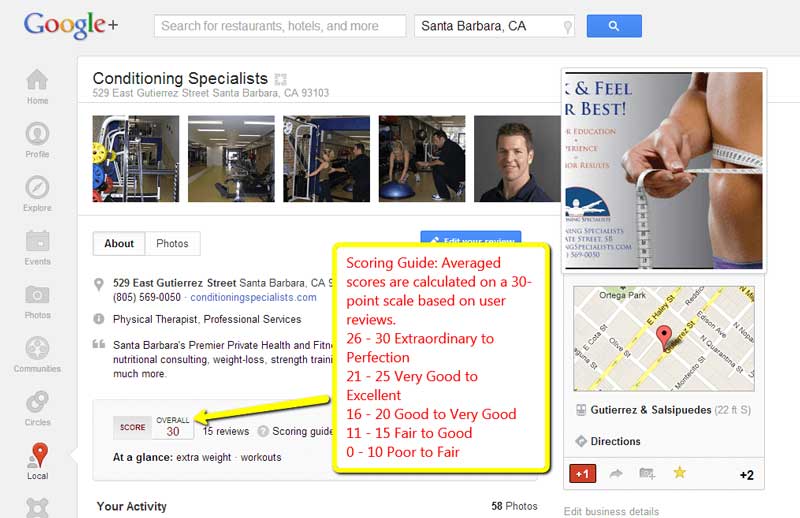[Originally posted in Fitness Professional Online February 2013 Issue] Local SEO has become increasingly important for businesses of all sizes. Small to medium-sized businesses are affected the most and thus have to compete at a higher level. With so many people searching via their cell phones and mobile devices, Google’s algorithm has increasingly moved towards relying on displaying local results. Google’s search results are also filtered by location and a user’s previous experiences. 
So how do you get listed locally?
It’s important to understand that there are two main types of local listings and for this example, we’ll use Conditioning Specialists – a private personal training studio located at 529 E. Gutierrez St. in Santa Barbara, CA 93103.
Organic Listings: The organic search results are the listings that come up naturally when someone searches for your company, service, or product. Wikipedia states: “Organic search results are listings on search engine results pages that appear because of their relevance to the search terms, as opposed to their being advertisements. In contrast, non-organic search results may include pay per click advertising.” 
Local OneBox: The Local OneBox is listed in outline form with capital letters such as “A, B, C, …” and so on. These listings correspond to the local map listings found in Google. These listings also seem to dominate the screen above the fold since they take up so much real estate. Google uses your computer’s IP address, or your mobile device’s GPS, to determine your location and thus what results are most meaningful to you. For example, if you search for “Personal Training” and are in the Santa Barbara or Montecito area, then Conditioning Specialists will come up first on the map listing. If you happen to be in Manhattan, you’ll get a local listing for that area. Of course, you can add a modifier: city, state, zip code, or another location-dependent variable.
Often, the location results for the organic and the local OneBox are different. This tends to cause lower rankings in Google and thus makes it harder for your clients to find you. One way to prevent this is to search for your business in both structured and unstructured citations.

Structured citations are formalized address listings that Google is taking from other locations and recognizing as a valid listing. These can be listed from your website, Yelp.com, or other formal directories. Unstructured citations are listings that come from articles written, press releases, and blogs. They don’t have the schema.org markup and they’re not coming from necessarily a trusted local citation provider.
You must run a check to ensure that all listings maintain the same NAP (Name, Address, and Phone number. Many business owners are surprised by mistakes and errors on directory pages that only hurt their chances of reaching the number one spot. One way to check is to use a free service such as Getlisted.org.
All of the local sites, directories, and your main website must be optimized for local search. It’s also important to consider where else on the web your business might be mentioned. Perhaps your business was mentioned in a local paper that maintains copies of their resources online for its readers? Or maybe you’re a member of your local chamber of commerce and they have listed you incorrectly. You’ll want to contact each webmaster and ask them to correct the address – keep it consistent!
In the example, Conditioning Specialists has been found with multiple listings:
- 529 E. Gutierrez, Santa Barbara, CA 93103 Phone: (866) Fit-in-SB
- 529 East Gutierrez, Suite C, Santa Barbara, California 93103 Phone: (805) 569-0050
- 529 E. Gutierrez, SB, CA 93103 Phone: 569-0050
Although most people would have no problem finding the Conditioning Specialists studio, the robots that crawl these websites can’t make that same distinction yet.
You can find these mentions by going to Google.com and putting into the search box “your business name -site:yoursite.com” (replacing “yoursite.com” with your website). For example, with Conditioning Specialists, we’d enter Conditioning Specialists -site:conditioningspecialists.com. 
You’ll also want to check the usual places such as Yelp and Citysearch come up. Special Events, press releases, and write-ups, bios, etc, are going to be very unstructured reviews typically. But anytime your business is going to be mentioned anywhere around the web, on some other website, you should try to ensure that your full address, phone, and business name are being listed correctly.
It’s also suggested that you do the same for job ads, ads in general, and all other posts on the web, including social media.
Follow these steps and you’ll be climbing towards the top of the search engines in your area. Of course, there’s a lot more that can be done, and if you have questions, please feel free to let me know. Get listed, get found, and get more business!
 I've helped thousands of people break through personal barriers and grow their business to heights previously unimagined. Read more
I've helped thousands of people break through personal barriers and grow their business to heights previously unimagined. Read more 

